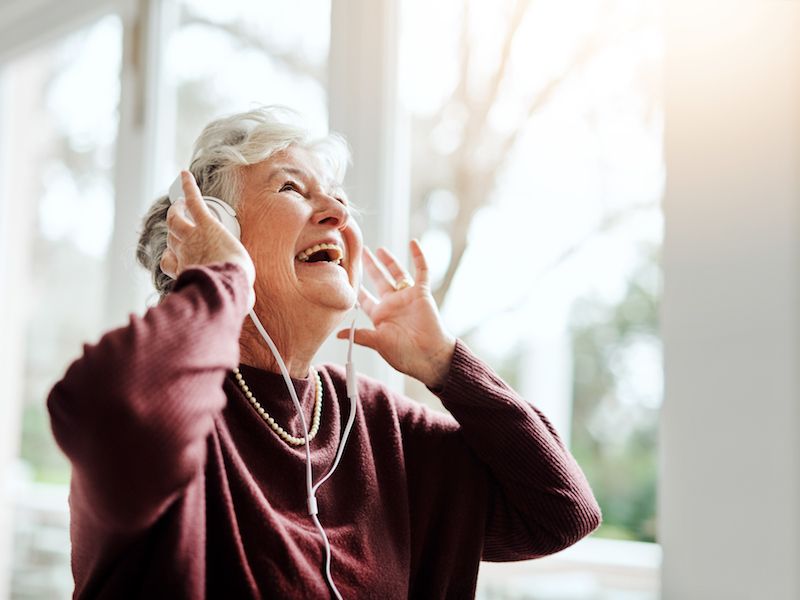
People who work in loud environments such as construction sites or at heavy metal concerts are not the only people affected by noise related hearing loss. Recreation related noise exposure can be just as damaging as work related noise exposure. The most prevalent type? Music, gaming, streaming video or anything that you would listen to through earbuds or headphones.
You might not believe your smartphone or tablet can go that loud. The average pain threshold for human hearing is about 150 db which is in the range of these devices. Your ears will actually start to hurt at this volume. So what’s the solution for safeguarding your hearing against volume related injury.
The volume level here is essential. An easy shorthand that’s widely recommended is the 60/60 rule: Listen with the volume at no more than 60% for 60 minutes or less at a stretch (because how long you listen for matters, too).
Your Hearing Aids Can be Set up For Listening to Music
If you wear hearing aids, you’re likely streaming your mobile device right to your hearing aids, so be certain the volume is not too high or that you’re not trying to drown out other sounds with your music. In addition, consult us about how to best listen to music. If you’re a musician or real music aficionado you might have noticed that most hearing aids are developed to improve the quality of voices…not necessarily music. While enjoying music, we can most likely make a few adjustments to help better the quality of sound and lessen the feedback.
What Are The Right Headphones For You?
If you don’t own hearing aids, there are a lot of options for shopping for headphones. There are various things to consider, though it’s generally a matter of personal choice.
Headphones That go Over The Ears
Over the ear headphones are becoming popular again but you most likely won’t find the old foam covered speakers that used to come with a walkman. They have lots of choices in color and style, are often endorsed by celebrities, and can be unexpectedly costly. And unlike those little foam pads, these cover the entire ear, blocking outside noises.
Main-stream wisdom is that these are less dangerous than in-ear headphones because the source of the sound is further away from your eardrum. But the reality is they’re usually able to reach louder sound than the smaller kind, the speakers are a lot larger. Noise cancellation can be a helpful thing as long as you’re not missing needed sounds such as an oncoming car or truck. With that being said, because they cancel out outside noise, you can normally decrease the volume of what you’re listening to so it’s not loud enough to injure your hearing.
Earbuds
The normal earbuds are well known for inferior sound quality, but because they come with your phone lots of people still use them. Particularly, with newer Apple phones, it’s simply easier to use the earbuds that came with the device because it probably doesn’t have a headphone jack.
Earbuds also don’t cancel out sound so the downside is, you have a tendency to turn up the sound level. It’s commonly thought that placing earbuds so close to your eardrum is the main issue but it’s really the volume.
Occluding or Isolating Earbuds
More comfortable than ordinary earbuds, models that have a round rubber tip are the choice of many because they help stop outside noise. The rubber molds to the shape of your ear, producing a seal that stops other noises from entering. Not to sound like a broken record, but these have the same drawbacks as the other two (it’s all about the volume), as well as carrying the same caution as over-the-ear headphones (they can block out warning sounds). Obviously, these won’t work for you if you wear hearing aids.
You might need to test out quite a few pairs before you find headphones that work for you. Depending on what you regularly use them for say talking on the phone, as opposed to listening to music, you’ll have different acoustic expectations. Enjoying your music at a safe volume and coming across headphones that assist you in doing that is essential.
Don’t Cut Corners When Dealing With Your Hearing
Is it Safe, How Can I be certain? There’s an app for that…If you use a smartphone, you can get the National Institute for Occupational Safety and Health’s free Sound Level Meter app. There are different apps you can get, but research has found that the dependability of these other apps is spotty (also, for whatever reason, Android-based apps have been shown less accurate). That prompted NIOSH to develop their own app. The app lets you measure external sounds, but sounds coming from your device’s speakers can also be measured, so you will learn precisely how much volume your ears are getting. It’s a little bit of effort, but putting in place these kinds of protective steps can help protect your hearing.
